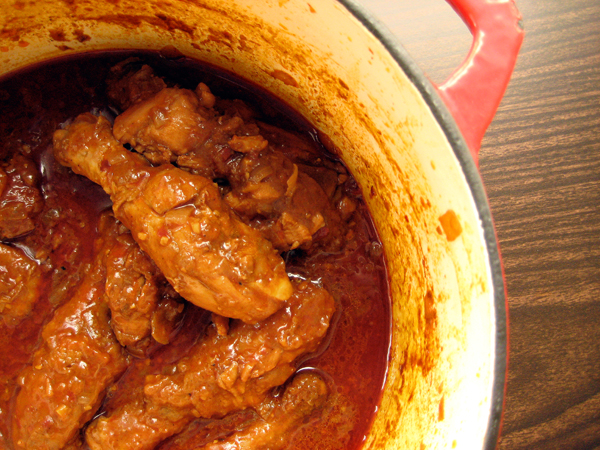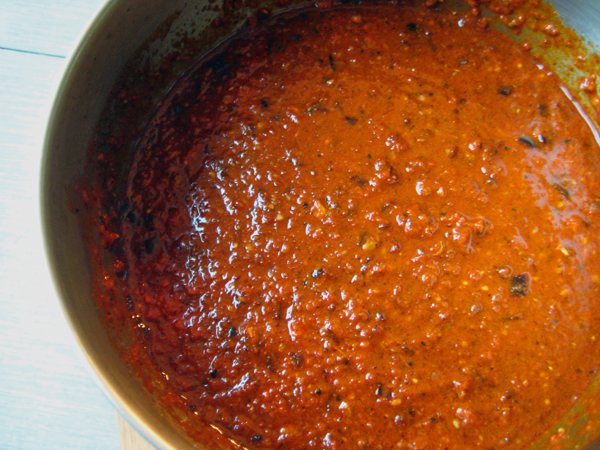
Thanks to all of you and your voting prowess, we made it past round #1 of Project Food Blog! Yay! This is my entry for challenge #2: attempt a classic dish from an unfamiliar culture.
We had a tutor when we were growing up in Hong Kong. She used to come to our house on weeknights, maybe 3 times or so in a week, to help us with our homework. My sister and I referred to her as 姐姐, calling her “big sister” in Cantonese because in many ways, that’s who she was. She was in her 20s, studying at the university, and sure, she helped us with our homework, but she also played games with us and took us out on fun outings.
姐姐 was a gentle soul with a seemingly unending source of patience for dealing with two unruly girls who, while they may be good at math, were not so good at actually sitting down to do their math. Little hooligans that we were, we sometimes frustrated her so much that she broke down in tears, causing my grandmother to rush into the room to play referee. In my mind, though, what I remember most about 姐姐 is the time she taught me about the world.

You see, when I was little, Hong Kong seemed like an enormous place. Going from one end of the city to the other took hours and surely, no other place could be nearly that huge. I remember once asking 姐姐 to point out Hong Kong on a world map and she complied. When she touched her finger to the paper, I thought she was pointing at all of Asia and I felt vindicated, “See? I knew Hong Kong is huge!” Patiently, she explained that my city, this ginormous city in which I lived, is merely a teeny tiny dot on the map. And that China is a blob, albeit a rather large blob, within this even bigger blob called Asia. And this Asia? It’s merely one continent out of a grand total of seven. The world, in that single moment, became a much much bigger place than I could have possibly imagined.
Even after moving halfway across the world, I’m still astounded by the enormity of our world. But these days, my fascination has less to do with physical distances and blob sizes on maps and more to do with the more abstract notion of cultural distances. I will be the first to admit that I know next to nothing about a huge swath of the globe. If you, for example, asked me about Africa, all I would be able to tell you is what I’ve seen in movies and television documentaries and let’s face it, I will most likely offend every single person from Africa who comes upon this site.


So let’s not do that. Instead, let’s talk about food, that which easily bridges even the greatest of cultural divides. In the kitchen, the only trip I’ve made to the African continent is to Morocco via a fragrant vegetable tagine. But having recently tasted some incredible Ethiopian food in DC (the best in the country, I’m told), I’ve been itching to venture further into an unknown land. What better place to begin, then, than with doro wat, said to be the most popular traditional food in Ethiopia?
Doro wat is a spicy chicken stew made using a spice paste called berbere and a spiced clarified butter called niter kibbeh, which I like to think of as “ghee amplified.” It begins with a unique step of dry-frying onions in the absence of any fat to draw out moisture, which works to thicken the stew later on during cooking. Some recipes I found even call for the onions to be cooked without fat for hours, but that’s an experiment I’m saving for another day.
Who knows? Maybe one day, I will get myself to Ethiopia. But until then, at least I know I can inch just a little bit closer with this Doro Wat.
This recipe is the result of combining three I found online, at Pretty Peas, African Kitchen, and Congo Cookbook. All three are similar in their ingredients lists and differ mostly in the amounts, so I improvised. Because there’s nothing I hate more than overcooking eggs, I opted to soft-boil the eggs and omit adding them to the stew until serving. The more traditional way calls for hard-boiling the eggs first, then simmering them in the stew for the last 15 min of cooking. Do what you like.
Make the niter kibbeh the night before while you settle in for a movie or a television show – I guarantee you won’t regret it. But if you’re really doing this last minute, substituting an equivalent amount of butter should work.
For the spices, the measurements are generally for the ground versions, so if you are using whole spices, keep in mind that you’ll end up with less volume after grinding. I usually increase the amounts by 1.5- to 2-fold to adjust, depending on how chunky the whole spices are.









38 Comments
That looks AMAZING! I’m rooting on the sidelines for pfb2010 now, but you have my support. I love ethiopian cuisine. I have to try this! Good luck!
Thanks so much Kimmy! I have to admit I haven’t had much Ethiopian food myself but when I had this dish in DC, I immediately fell in love. On another note, I love that PFB has introduced me to so many awesome bloggers – how fun!
Whoa! certainly exotic and far out of the comfort zone but looks delicious none the less.
Thanks for reading, Wizzy! You know what’s really exotic? Marmee apple – I have never heard of them until I read your post. Super excited to have found your blog and can’t wait to read more about life in the Caribbean!
Good luck with the competition! This is such a delicious sounding dish, full of flavour!
Thanks for visiting Maria! I’ve never been to Finland or Australia so I can’t wait to read more about both places (and the food, of course) on your blog.
By the way, how did you find me? :)
This looks so, so good. Filing this one away for a cold day when we’re in the mood for a stew, and I’m going to keep this in mind to try at the Ethiopian place down the street from me.
Thanks Elizabeth! You should definitely give this a try – I bet the Fairway has all the ingredients you need. ;) Let me know how it turns out!
Look out, Marcus Samuelsson! This sounds totally up my alley. Thanks for posting this; I’ve been curious about this dish. We should get together and try to make the injera, huh?
Thanks Ben! I thought about mentioning how I also like the way Marcus Samuelsson says the word “berbere” but then I realize it sounds creepy and too fangirl-ish. I still can’t get the injera the way I want – mine still comes out too crisp and crepe-y, instead of the soft, moist, pillowy goodness I like. So yes, we should try to make this together, maybe with real teff flour next time. Bob’s Red Mill sells teff, apparently. Go Bob!
I absolutely love Ethiopian food, and I agree with those who told you that DC has the best in the U.S. Thanks for experimenting with and sharing this recipe; I love this dish and look forward to making it one weekend. Going to vote for you now!
Thanks for reading and voting, Stephanie! No kidding, DC has the best Ethiopian food – it’s not even fair to try to compare our SF ones against them. :) Let me know when you make this and how it turns out. Super excited to learn more about local food from your blog too – thanks for finding me!
Love the photographs! Love the blue bowl of spices. And love the label on your niter kibbeh… it’s something people don’t do (myself included, sometimes!) I have never had Ethiopian food but your stew just looks so good… I’m drooling! I’d have to try this out sometime soon. Great post!
Thanks Jun! Actually, don’t tell my boss, but I took that roll of lab tape home because I love to use it to label stuff in my kitchen. Shh! Definitely save this recipe for a chilly day — it’ll warm you right up!
Wow–the flavors are popping out of my screen! I love Ethiopian food and yours looks divine. Beautiful photos and I loved reading your story. Easy vote for you :)
Thanks Sarah! Your mole looks absolutely delicious too and also, I love the phrase “foray into mole”. Good luck in PFB!
I love Ethiopian food. In fact 2 weeks ago, I just posted two Ethiopian series, one is about food and culture and another one is a bout Ethiopian coffee ceremony.
Thanks for visiting, Pepy! And great mind must think alike, right? Since we both thought of Ethiopian around the same time. :) Your post about the coffee ceremony is so interesting – thanks for sharing!
@junbelen @angi Haha I TOTALLY use VWR markers, tough spots, cryo-babies, TZ-241 tape, etc to label. It’s just too practical not to!
Hehe… glad to hear I’m not the only one! ;)
Love your childhood story, and I too thought HK was a huge place until I moved to the U.S. Your stew looks amazing, and love that it has all the spices. Great post and you got my vote. Good luck!
Thanks Margaret! I’m voting for you too because I love your post on samosas. You know what, I had no idea until recently that HK has such a big Indian population and now, I think about all the awesome Indian food I missed out on when I was there! Your parents sound super cool to take you to try Indian food when you were young. ^_^
Hey, Pretty Peas–that’s me! Yay! :D Is it bad that this is the most exciting part of my week? …. ;)
That looks so beautiful and delicious. Great job!
Thanks Heather/Pretty Peas! The Stevens Point cake you have on your blog right now looks so gorgeous, almost, like you said, like a Jackson Pollack painting. Except much tastier than one, of course!
I made this too. I loved it! Your pictures are so much prettier than mine, though. :)
Thanks Mariko! I love that you also made Doro Wat – does that make us partners in culinary crime?
I have actually never had Ethiopian food, but this looks really delicious! You have my vote! Best of luck to you!
Thanks Amy!
Wow, that looks so yummy! I would never have thought to even try cooking ethiopian cuisine. There are a few places in SF and LA to try Ethiopian/Eritrean food, but to cook it?! I wouldn’t even know where to begin.
Good luck on the FoodBuzz contest!
Thanks Suki! I’m always looking for another country to “travel” to, so this PFB challenge was the perfect excuse to make the trip to Ethiopia. I actually haven’t had much Ethiopian food in SF — any recommendations?
Well done–the writing and the food. I originally intended to make some type of African stew and ended up with something else. This kind of chicken stew is perfect comfort to me. I felt good reading your post and even better staring at your pictures. Very nice. :-)
Thanks Jean, such a sweet comment from an awesome photographer like you means a lot to me! Also, it looks like many people had the same idea of making an African stew, so you’re smart to go elsewhere. :)
That looks delicious! Love how spicy it looks – I voted for you! :D
Thanks Biz! Wow, did you really make three dishes for this challenge?? Hardcore!
This definitely looks amazing and I love the back story also! Good luck!
Thanks Peggy!
Nice entry. I’m voting. Good luck!
Thank Joan!
One Trackback
[…] you like what I wrote about Doro Wat, a ridiculously flavorful and beautifully red Ethiopian chicken stew? If so, then maybe you want to […]